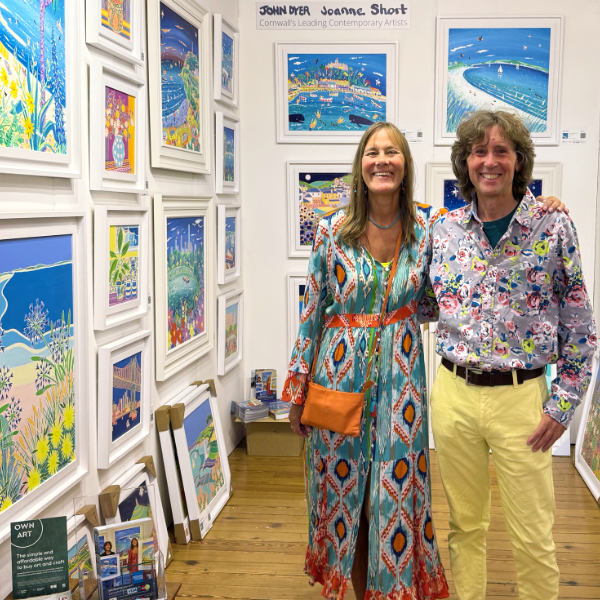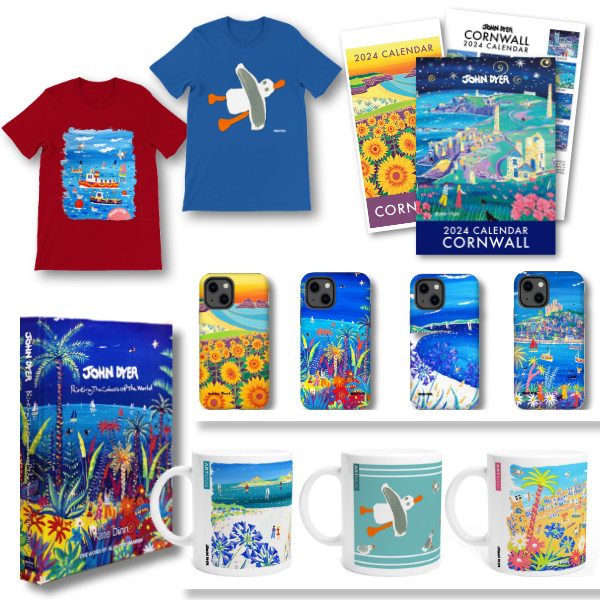Christmas Exhibition Paintings Live 10am Saturday 23rd November & Private View December 6th in St Ives!
Christmas Exhibition Paintings Live 10am Saturday 23rd November & Private View December 6th in St Ives!
Invest in British Art from Cornwall's Leading Artists | Free Worldwide Delivery
JOHN DYER
Original Paintings
New paintings available to buy online now by Cornwall's best loved artist.
JOANNE SHORT
Original Oil Paintings
New paintings available to buy online now by Cornwall's acclaimed colourist painter.
TED DYER
Original Oil Paintings
New paintings available to buy online by Cornwall's best known impressionist artist.
All Original Paintings
View all of the new original paintings that we have available to buy online now in our online gallery.
The ones you missed
View all of the recently sold original paintings by our Cornish artists John Dyer, Ted Dyer and Joanne Short.
Cornwall Art Prints
Museum-quality prints. Framed, Unframed, Signed & Wall Art Posters
Christmas Exhibition St Ives 2024
Private View: 6th December 6pm to 8pm
Exhibition continues: 7th - 8th
Summer Collection 2024
Online exhibition of new paintings by John Dyer & Joanne Short.
Easter Exhibition St Ives 2024
New paintings by John Dyer & Joanne Short in the historic Porthmeor Studios in St Ives.
Explore our Previous Exhibitions
Enjoy exploring our previous exhibitions and discover amazing paintings.
Art Collectors Club.
Enjoy 5% off your first order, regular offers, exclusive exhibition invitations and artist and gallery updates in our monthly email newsletter.
Edward Lear (1812–1888) is celebrated as a pioneering figure in the world of landscape painting and as a beloved writer of nonsense verse. Born in Holloway, London, Lear was the youngest of 21 children in a modest family. Despite facing financial difficulties and health challenges, including epilepsy and poor eyesight, Lear's extraordinary talent and creativity propelled him to prominence in the visual and literary arts.
Lear began his artistic career as an ornithological illustrator, producing detailed and scientifically accurate illustrations of birds for various publications. His work in this field, particularly his illustrations for John Gould's "The Birds of Europe," earned him early acclaim and provided a strong foundation for his later artistic endeavours. However, his passion for travel and landscape painting soon took precedence.
In the 1830s, Lear transitioned to landscape painting, inspired by his extensive travels across Europe and the Mediterranean. His journeys took him to Italy, Greece, Albania, Egypt, and the Indian subcontinent, among other destinations. These travels profoundly influenced his work, as he captured the diverse and picturesque landscapes with a distinctive blend of topographical accuracy and poetic sensibility.
Lear's landscape paintings and watercolours are characterized by their luminous quality, meticulous attention to detail, and evocative sense of place. His ability to convey the grandeur and tranquillity of nature made his works highly sought after by patrons and art lovers. Notable paintings include "Corfu from Ascension," "The Plains of Lombardy from Monte Generoso," and "Mount Athos and the Monastery of Stavroniketa," each showcasing his exceptional skill in capturing the beauty and essence of his surroundings.
In addition to his achievements in the visual arts, Lear is also celebrated for his contributions to literature, particularly his whimsical and imaginative nonsense verse. His most famous work, "A Book of Nonsense" (1846), features a collection of limericks and playful poems that have delighted generations of readers. His nonsense verse is marked by its inventive language, humour, and charm, exemplified in beloved poems such as "The Owl and the Pussycat" and "The Jumblies."
Lear's dual talents as a painter and poet earned him a unique place in the cultural landscape of the 19th century. His ability to traverse the visual and literary arts with such success is a testament to his remarkable creativity and versatility. Despite his struggles with health and personal hardships, Lear maintained a spirit of curiosity and joy that is reflected in his work.
Edward Lear passed away in 1888 in San Remo, Italy, leaving behind a rich legacy that continues to inspire and enchant. His landscapes remain admired for their beauty and precision, while his nonsense verse is a testament to his imaginative genius. Lear's work celebrates the natural world's wonders and the human imagination's boundless possibilities, making him a cherished figure in both the art and literary communities.
Explore our main art collections to find perfect original paintings, limited edition signed prints, open-edition prints, wall art prints and posters & artist designed gifts.
N.B. If you don’t see your confirmation email shortly, please check your spam or junk folder.
A lovely art print bought as a memory of our holidays on the beautiful Isles of Scilly.
The frame is very well made and displays the art print beautifully. Ordering from John Dyer Gallery was simple and delivery swift. I would not hesitate to order from them again.
Thank you so much for the amazing customer service, and most beautiful painting of our favourite place
Absolutely beautiful painting. So thrilled with it. Completely amazing service: beautifully packaged, framed and safely delivered really quickly.
Lovely picture, bought 3 after our recent trip to Cornwall. Already thinking of getting more.
Have walked this coastal path from St Agnes to Chapel Porth and back countless time. I am now pleased that this fabulous print is the first thing I see every morning. Beautiful, happy colours. Nice frame. I’m now planning of ordering one of Mount’s Bay by same artist.
Such a vibrant, pretty piece. I visited Fowey Harbour recently and was looking for a small keepsake to have with me back in the U.S. Shipping abroad was seamless and I received this item quite quickly. I've had many compliments since putting this on my phone and am happy to be reminded of a wonderful trip to a magical place this summer.
As always professional , efficient and prompt .
We have been coming here for 27 years together. This is our place especially during lockdown. John has captured our place beautifully. I have many of John’s prints, always in my birthday, so this one for June is 😍 perfect. They always make me smile, colourful, fun and look perfect in our home
I found the whole experience flowed from start to finish. The customer service was exceptional, they couldn’t do enough for me. This is the kind of first rate service I would expect from such a professional artist. Thank you.
Lovely,bright and colourful ready to hang.
Bought back lovely memories.
Posted promptly too.
Thank you.
I have loved John Dyers work for many years. I have some prints at home and at work.
Gorgeous, vibrant colours. Reminds me of many happy evenings at the Minack when growing up in Cornwall. Special memories.
great service. Thank you.
I purchased “Bathing Belles” to add to 2 other John Dyer original paintings collected over the years .
We decorated our house and removed another trio of prints , so were hoping to find something suitable at John’s latest exhibition.
We were not disappointed . The colours are vivid and the painting has elements of my childhood : a trip on the Enterprise boat , snd swimming in the sea . There is also a signature seagull (oh how I love those seagulls !!) a chough , a puffin and a friendly seal . I like the play on the words in the title, with bluebells in the foreground .
The off white frames complement the colour palette perfectly .
I was extremely impressed on how quickly the painting was delivered after the exhibition - I had expected to wait at least a couple of weeks , but within days it was with me . As always it was packaged very carefully .
Stripy Swimmers is a joyous riot of exquisite colours and shapes. It has pride of place in my sitting room. Every day it lifts my spirits and energizes me to be creative myself. Thank you Joanne, your unique painting has a very happy home. Thanks also to you John for your expert eye - the frame perfectly enhances the explosion of colour. It was so robustly packaged I wouldn't hesitate to buy from the gallery again knowing that it will arrive safely. I am a very Happy Customer!
We have loved and been visiting Holywell bay for over 25 years. It's a real home from home for us. This picture captures the place for us perfectly.
The paper is such good quality, certainly worth the cost. Delivery was effortless.
WOW Environmental inspired art at it's best.Bright and bold and mesmerising. John Dyer was very easy to contact and accommodating with dates for shipping




